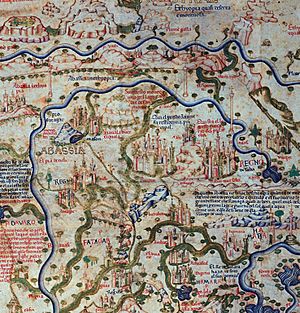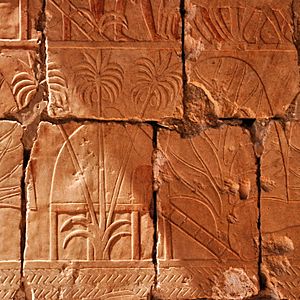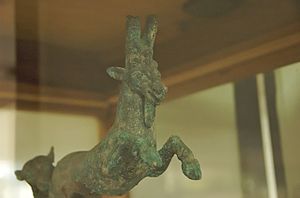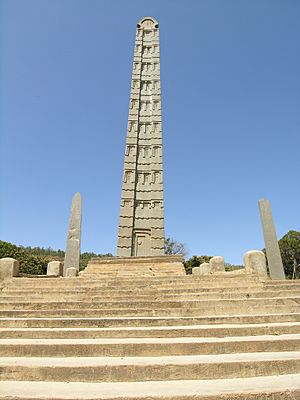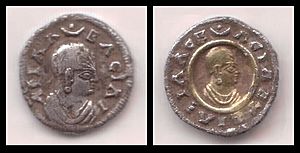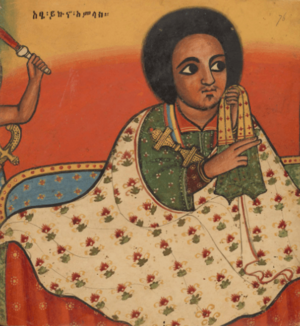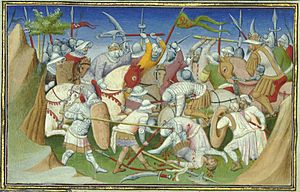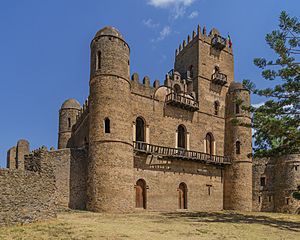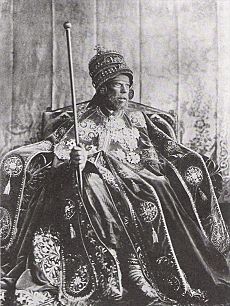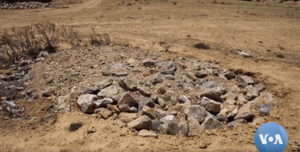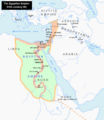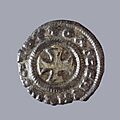History of Ethiopia facts for kids
Ethiopia is one of Africa's oldest countries. Its amazing history goes back thousands of years! Over time, people moved around and the empire grew. This led to many different groups joining Ethiopia, like the Amhara, Oromos, Somalis, and Tigray. They mostly speak languages from the Afro-Asiatic family.
One of the first powerful kingdoms was D'mt, which started around 1000 BC. Its capital was Yeha. Later, in the 1st century AD, the Aksumite Kingdom became very strong in the Tigray Region, with its capital at Aksum. It became a major power near the Red Sea, even controlling parts of South Arabia. In the early 300s AD, during the rule of King Ezana, Christianity became the official religion. King Ezana was also the first to call his people "Ethiopians". The Aksumite empire slowly weakened as trade routes changed after the rise of Islam. It became cut off, its economy suffered, and its power ended. The Zagwe dynasty then took over, building a new capital at Lalibela. In the 13th century, the Solomonic dynasty began. During this time, Ethiopia became very powerful in the Horn of Africa through military changes and expanding its empire.
Contents
Ancient History: Early Kingdoms
The Land of Punt
Ancient Egyptian traders, starting around 3000 BC, talked about lands south of Nubia called Punt and Yam. Recent discoveries of Egyptian baboon mummies in modern Ethiopia and caves in Somaliland suggest Punt was in the Horn of Africa.
The Egyptians valued products from Punt like myrrh, ivory, animal skins, and ostrich feathers. This shows that trade between Egypt and Punt happened very early. The Greek historian Agatharchides wrote that Egyptian ships sailed the Red Sea to the "myrrh-country" during the Old Kingdom (3000-2500 BC).
The first known trip to Punt was around 2500 BC under Pharaoh Sahure. The most famous trip was by Queen Hatshepsut around 1495 BC. Her temple at Deir el-Bahri shows her trading group bringing back myrrh trees, myrrh, elephant tusks, gold, and exotic animals. Egyptians sometimes called Punt "God's-Land" because of its valuable resources.
Punt likely ended around 1000 BC, possibly due to tensions between different groups. It may have split into two kingdoms: Macrobia and D'mt.
The D'mt Kingdom
The first known kingdom in Ethiopia was D'mt, which rose around 980 BC. Its capital was Yeha, where a temple similar to those in Saba (Yemen) was built. For a while, people thought D'mt was a Sabaean colony. However, now historians believe Sabaean influence was small and didn't last long. It might have been a trading outpost or a military alliance.
Not many records or archaeological findings from D'mt survive. So, we don't know if D'mt ended before the Aksumite kingdom began, or if it slowly became part of Aksum.
The Aksumite Kingdom
The first truly powerful kingdom in Ethiopia was Aksum, which started in the 1st century CE. It was one of the kingdoms that followed D'mt. Aksum managed to unite the northern Ethiopian Highlands around the 1st century BCE. They expanded southward from their bases. A Persian religious leader named Mani even listed Aksum as one of the four great powers of his time, alongside Rome, Persia, and China.
Historians are still unsure about the exact beginnings of Aksum. We don't even know for sure who the earliest king was. Coins showing royal portraits began to be made around the end of the 3rd century CE under King Endubis.
Christianity Arrives
Christianity came to Ethiopia through Frumentius, who became the first bishop of Ethiopia around 330 CE. Frumentius converted King Ezana. Ezana's early writings thank a god of war for his victories. But later writings show his strong belief in Christianity, and his coins changed from showing a disc and crescent to a cross.
Ezana's kingdom expanded, possibly leading to the fall of the Kingdom of Kush in Sudan. Aksum then shared a border with the Roman province of Egypt. Aksum was at its most powerful under Ezana and King Kaleb. They had a large trade network that reached as far as India and were always in touch with the Byzantine Empire.
In the 6th century CE, Aksum controlled parts of Yemen. Around 523 CE, a Jewish king named Dhu Nuwas came to power in Yemen. He attacked Christians, burning churches and killing those who wouldn't convert to Judaism. The Roman Emperor Justin I asked King Kaleb for help. Around 525 CE, Kaleb invaded Yemen and defeated Dhu Nuwas. This was the last time Ethiopian armies left Africa until the 20th century.
The end of the Aksumite Kingdom is a bit of a mystery. It might have been caused by long droughts, too much grazing, cutting down too many trees, a plague, or changes in trade routes. All these factors could have played a part.
Middle Ages: New Dynasties
The Zagwe Dynasty
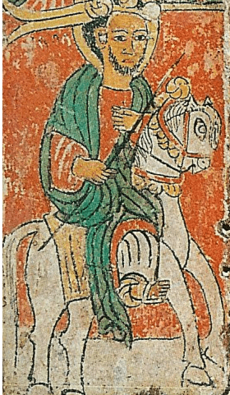
Around 1000 AD, a Jewish princess named Yodit (or "Gudit") is said to have tried to kill all the members of the royal family to become queen. Legend says a baby heir was saved and taken to Shewa. Gudit ruled for 40 years. While parts of this story might be exaggerated by later rulers, it's known that a female ruler did conquer the country around this time.
Later, an Agaw lord named Mara Takla Haymanot overthrew Yodit's successors. He started the Zagwe dynasty, named after his people. The Zagwe kings made their capital at Roha (now Lalibela). They built amazing monolithic churches, carved right out of rock. Many of these are linked to King Gebre Mesqel Lalibela. The Zagwe architecture continued earlier Aksumite styles.
The Zagwe dynasty ruled a smaller area than Aksum. They seemed to have a peaceful kingdom with a strong culture. The church and state were very close, and some Zagwe kings were even made saints.
Connecting with Other Christians
Unlike the Aksumites, the Zagwe were quite isolated from other Christian nations. However, they kept some contact through Jerusalem and Cairo. Ethiopian monks had chapels in Jerusalem, including at the Church of the Holy Sepulchre. After Saladin took Jerusalem in 1187, he invited Ethiopian monks to return and even removed the pilgrim tax for them. This shows Ethiopia's connections during the Crusades.
Later, around the early 1300s, Emperor Wedem Arad sent a group of 30 people to Europe. They visited the Pope in Rome and then the Antipope in Avignon. They also traveled to France, Spain, and Portugal, hoping to form an alliance against Muslim states that threatened Ethiopia. While no alliance happened, this trip brought Ethiopia back to Europe's attention.
The Early Solomonic Period (1270–16th Century)
Around 1270, a new dynasty began in the Ethiopian highlands under Yekuno Amlak. This new dynasty claimed to be direct descendants of the Aksumite kings, linking them back to King Solomon and the Queen of Sheba. This story was written down in the 14th century in the Kebra Nagast, which helped make their rule seem more legitimate.
Under the Solomonic dynasty, the main regions were Tigray, Amhara, and Shewa. The ruler, called nəgusä nägäst (King of Kings), usually lived in Amhara or Shewa. He collected taxes from other regions when he could.
The early Solomonic period saw military improvements and the empire expanded, especially under Amda Seyon I. There was also great progress in art and writing. However, cities became less important because the emperors moved their capital around in mobile camps instead of having one fixed city.
During this time, monasticism (monk life) grew strong. A religious leader named Abba Ewostatewos started a new group called the Ewostathians. They wanted church reforms, including observing the Sabbath (holy day of rest). They were persecuted but their movement grew. Eventually, under Emperor Zara Yaqob, a compromise was reached, bringing unity back to the Ethiopian church.
Relations with Europe and "Prester John"
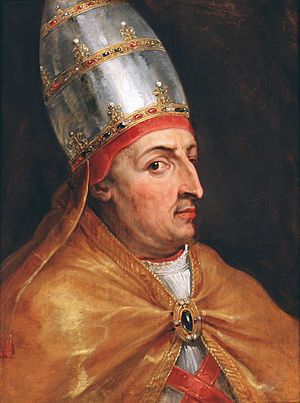
An interesting thing happened because of Ethiopian Christianity. Europeans had long believed in a Christian kingdom in the far east, ruled by a king called Prester John. Over time, the search for this mythical kingdom focused on Africa, especially Ethiopia.
When Emperor Zara Yaqob sent people to the Council of Florence in 1441 to connect with Western Christianity, the European church leaders kept calling their emperor "Prester John." The Ethiopian delegates tried to explain that this wasn't his name, but Europeans continued to use the mythical title.
Towards the end of the 1400s, Portuguese explorers began arriving in Ethiopia. One of them, Pêro da Covilhã, arrived in 1490. He thought he had found the famous kingdom and gave the Ethiopian emperor (Eskender) a letter from the King of Portugal, addressed to Prester John. Covilhã helped build good relations between the two countries.
In 1509, Empress Dowager Eleni asked the King of Portugal for help against Muslim threats. In 1520, a Portuguese fleet arrived, and an embassy visited Emperor Lebna Dengel. One of them, Father Francisco Álvares, wrote one of the first detailed accounts of Ethiopia.
The Ethiopian-Adal War (1529–1543)
Between 1528 and 1540, the Adal Sultanate, led by Ahmad ibn Ibrihim al-Ghazi (often called Gragn, "the Left-handed"), tried to conquer the Ethiopian Empire. With support from the Ottomans and other foreign fighters, they invaded much of the Ethiopian plateau. The Emperor had to hide in mountain strongholds.
The Empress asked the Portuguese for military help against the Ottoman guns. A Portuguese force of 400 musketeers, led by Cristóvão da Gama, arrived in 1541. They had some early successes but were later defeated, and their commander was killed. The remaining Portuguese soldiers joined forces with the Ethiopian Emperor Gelawdewos. Together, they defeated the Adal forces. On February 21, 1543, Al-Ghazi was killed in the Battle of Wayna Daga, and his army was completely defeated.
Oromo Migrations
The Oromo migrations were a series of movements by the Oromo people from southern Ethiopia to northern regions in the 16th and 17th centuries. These migrations greatly impacted the Solomonic dynasty and the weakened Adal Sultanate. They ended around 1710.
In the 17th century, Emperor Susenyos I relied on Oromo support to gain power and even married an Oromo woman. While relations were good at first, conflict started when the emperor tried to convert the Oromo to Christianity. Many Oromo then moved into Susenyos's territory.
Over the 17th and 18th centuries, many Oromo people gradually converted to Islam, especially around Harar. Scholars believe the Oromo converted to Islam to keep their identity and avoid being completely absorbed into Ethiopia.
The Gondarine Period (1632–1769)
Gondar became the third long-term capital of the Christian Kingdom, founded by Emperor Fasilides in 1636. It was a very important center for trade.
The Jesuits (Catholic priests) who had come to Ethiopia were eventually expelled. When Emperor Susenyos died and his son Fasilides took over in 1633, the Jesuits were sent away, and the traditional Ethiopian religion was restored as official. Fasilides made Gondar his capital and built a large castle complex there, known as the Fasil Ghebbi. He also built churches and bridges.
During this time, Ethiopian philosophy grew. Philosophers like Zera Yacob wrote about religion, morality, and reason. Gondarine art was influenced by Byzantine art and also by Western European paintings brought by the Jesuits.
Zemene Mesafint: Era of the Princes
The murder of Emperor Iyasu I and the decline of the royal family's power marked the beginning of the Zemene Mesafint ("Era of the Princes"). This was a time of disorder when local warlords became more powerful than the emperor.
Nobles started choosing emperors, and sometimes even became emperors themselves. For example, after Emperor Tewoflos died, nobles chose Yostos to be king, instead of a Solomonic family member.
Iyasu II became emperor as a child. His mother, Empress Mentewab, had a lot of power during his rule and also during the rule of her grandson Iyoas. Mentewab was even crowned as a co-ruler, the first woman in Ethiopian history to be crowned this way.
A power struggle grew between Empress Mentewab and the mother of Emperor Iyoas, Wubit. This led to different groups of nobles and their armies gathering in Gondar. Ras Mikael Sehul was called to help. He managed to take power for himself, becoming the leader of the Christian (Amharic-Tigrean) side.
Emperor Iyoas favored his Oromo relatives, which made his relationship with Mikael Sehul worse. Eventually, Mikael Sehul removed Emperor Iyoas from power in 1769. A week later, Mikael Sehul had him killed. This was a big moment because it was the first time an emperor lost his throne in a way other than natural death or giving up power willingly.
From this point on, the power of the emperor was much weaker, and the great nobles and military leaders held more control. This period is known as the Era of the Princes. This time of conflict also made Ethiopians wary of foreign Christians and Europeans, leading to Ethiopia's isolation until the mid-19th century.
Modern Ethiopia
From Isolation to Modernization (1855–1936)
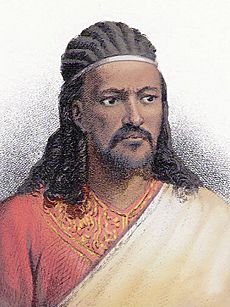
Under Emperors Tewodros II (1855–1868), Yohannes IV (1872–1889), and Menelik II (1889–1913), Ethiopia began to open up to the world. Emperor Tewodros II ended the "Era of the Princes."
Tewodros II (1855–1868)
Emperor Tewodros II was born Kassa in 1818. He started as a leader of a group of bandits, like a Robin Hood figure. His group grew into a strong army. He eventually became emperor in 1855, ending the rule of the Gondarine puppet emperors. He wanted to modernize his kingdom and bring all the regions under his control.
In 1865, Sahle Maryam (the future Emperor Menelik II) escaped from Tewodros's prison and became king of Shewa. Tewodros tried to make an alliance with Britain, but he died after a military defeat by the British.
Yohannes IV (1872–1889)
In 1868, a British force came to Ethiopia to rescue British citizens imprisoned by Tewodros. The British made a deal with Dajazmach Kassa (who would become Yohannes IV) to pass through his territory. After their mission, the British rewarded Kassa with weapons. This helped Kassa defeat the current emperor, Tekle Giyorgis II, in 1871. In 1872, Kassa became Emperor Yohannes IV.
Ethiopia was never colonized by a European power, but many European countries were interested in it during the 19th-century "Scramble for Africa." Italy bought a Red Sea port called Asseb in 1870 and continued to gain land, which later became the Italian colony of Eritrea.
Emperor Yohannes IV fought against the dervishes from Sudan. He died in battle in 1889. After his death, Sahle Maryam of Shewa declared himself Emperor Menelik II of Ethiopia.
Menelik II (1889–1913)
In 1889, Emperor Menelik signed the Treaty of Wuchale with the Italians. This treaty gave Italy a part of northern Ethiopia (which would become Eritrea) in exchange for rifles and cannons. The Italians told European powers that this treaty gave them control over all of Ethiopia. Menelik disagreed, saying the Amharic version of the treaty did not say that. His protests were ignored.
However, on March 1, 1896, Ethiopia completely defeated the Italian army at the Battle of Adowa. This battle secured Ethiopia's independence. A peace treaty was signed in October 1896, recognizing Ethiopia's independence.
Under Menelik's rule, Ethiopia expanded its borders to the south and east, incorporating new lands and people. This expansion shaped the modern borders of Ethiopia. During these conquests, there were many conflicts and hardships for the local populations. Slavery, which had existed in Ethiopia for a long time, continued in the new territories.
Iyasu V, Zauditu, and Haile Selassie (1913–1936)
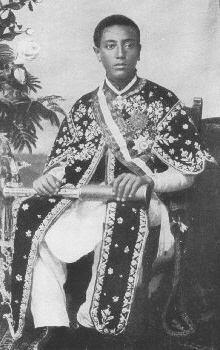
When Menelik II died, his grandson, Lij Iyassu, became emperor. But he lost support because of his ties to Muslim groups. In 1916, Christian nobles removed him from power. Menelik's daughter, Zauditu, became empress, and her cousin, Ras Tafari Makonnen, became regent and heir.
After Empress Zauditu died in 1930, Ras Tafari Makonnen was crowned Emperor Haile Selassie I. He took the throne name Haile Selassie. His full title was "His Imperial Majesty Haile Selassie I, Conquering Lion of the Tribe of Judah, King of Kings of Ethiopia and Elect of God."
Haile Selassie worked to modernize Ethiopia. He expanded education beyond the traditional church schools. He sent many young people to study abroad and opened new schools in cities. He also made the abolition of slavery a high priority, and it was finally achieved by 1942.
Italian Occupation (1936–1941)
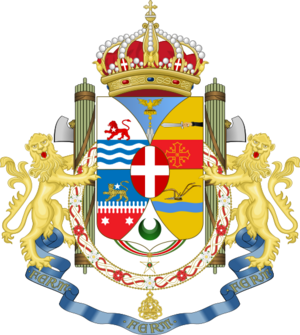
Emperor Haile Selassie's rule was interrupted in 1935 when Italian forces invaded and occupied Ethiopia. The Italian army, led by dictator Benito Mussolini, invaded on October 2, 1935. They took the capital, Addis Ababa, on May 5, 1936. Emperor Haile Selassie asked the League of Nations for help, but the country was formally taken over on May 9, 1936, and the Emperor went into exile.
Many Ethiopians died during the invasion and occupation. There were also reports of war crimes committed by both sides. Italy asked the League of Nations to recognize its control over Ethiopia, and most countries agreed, except for the Soviet Union. The King of Italy was crowned "Emperor of Ethiopia," and Italy created an empire in Africa called Italian East Africa, which included Ethiopia, Eritrea, and Italian Somalia.
The Italians invested in building roads, railways, dams, and power plants in Ethiopia during their occupation. They also planned to bring many Italian colonists to live in Ethiopia. The occupation government closed Ethiopian church schools and replaced them with new systems: one for Italians and a basic one for native Ethiopians, focused on making them obedient.
World War II and After (1941–1974)

In spring 1941, the Italians were defeated by British and Allied forces, which included Ethiopian fighters. On May 5, 1941, Emperor Haile Selassie returned to Addis Ababa and took back his throne. After Italy's defeat, Ethiopia was under British military control for a short time, but full independence was restored in 1944. Eritrea became an independent part of Ethiopia in 1952, but later fought for its own independence.
After World War II, Emperor Haile Selassie continued to modernize Ethiopia. The first major university, University College of Addis Ababa, was founded in 1950. The constitution was updated, giving more power to the Parliament. Haile Selassie also worked to improve Ethiopia's relationships with other African nations, helping to create the Organisation of African Unity in 1963.
In 1961, the 30-year Eritrean Struggle for Independence began. This happened after Emperor Haile Selassie dissolved the federation with Eritrea and closed its parliament, making Eritrea the fourteenth province of Ethiopia in 1962. The war was very costly for Ethiopia.
By the early 1970s, Emperor Haile Selassie was very old. People started to question who would rule next and if the monarchy was still the best system. The government's failure to make big economic and political changes, along with rising prices, corruption, and a hidden famine, led to widespread unrest. The military began to organize a revolution.
The Communist Period (1974–1991)

After protests began in February 1974, a group of soldiers called the Derg ("committee") took power from Emperor Haile Selassie on September 12, 1974. They set up a government that was socialist and military-led. The Derg quickly executed 59 former government officials. Emperor Haile Selassie died in 1975.
Lt. Col. Mengistu Haile Mariam became the head of state. The new government made socialist changes, like taking over land from landlords and the church. Mengistu's rule was very strict, and the country became heavily militarized with help from the Soviet Union and Cuba.
The new government faced armed resistance from landowners and royalists, especially in Eritrea. The Derg chose to fight in Eritrea rather than negotiate. By mid-1976, the resistance controlled most of Eritrea.
In July 1977, Somalia attacked Ethiopia over land claims in the Ogaden region. Ethiopian forces were pushed back, but with massive help from the Soviet Union and 17,000 Cuban soldiers, they stopped the attack. The last major Somali units left in March 1978.
From 1977 to 1978, thousands of people suspected of being enemies of the Derg were killed in a violent purge called the Qey Shibir ("Red Terror"). Communism became official in the late 1970s. In 1987, a new constitution was approved, and the country was renamed the People's Democratic Republic of Ethiopia. Mengistu became president.
The government's power weakened due to droughts and a severe famine that killed about 1 million people. There were also uprisings, especially in Tigray and Eritrea. The government also forced many people to move from their homes. In 1989, different opposition groups formed the Ethiopian Peoples' Revolutionary Democratic Front (EPRDF). In May 1991, EPRDF forces moved into Addis Ababa. Mengistu fled the country.
Hundreds of thousands of people died during this period due to the Red Terror, forced movements, or famine. In 2006, Mengistu was found guilty of very serious crimes. The Derg government also moved many Amhara people to southern Ethiopia, where they worked in government and schools. They tried to reduce the use of other languages to promote a single Ethiopian identity.
Recent History (1991–Present)
In July 1991, the EPRDF and other groups formed a temporary government. Eritrea separated from Ethiopia after a long war for independence.
In 1994, a new constitution was written, creating a two-house legislature and a judicial system. In 1995, Meles Zenawi became prime minister and Negasso Gidada became president. Meles was re-elected in 2000.
After the September 11 attacks in 2001, Ethiopia began to train with US forces to fight terrorism. In 2006, an Islamic group in Somalia, the Islamic Courts Union (ICU), grew quickly. Ethiopia sent support to the Somali government against them. Fighting broke out in December 2006, and Ethiopian forces quickly took over most of the areas held by the ICU. Ethiopian forces left Somalia in January 2009.
Meles Zenawi died in 2012 and was replaced by Hailemariam Desalegn as prime minister. In 2013, Mulatu Teshome was elected president.
In 2016, protests broke out across the country, especially from the Oromo ethnic group, demanding an end to human rights abuses and the release of political prisoners. Ethiopia declared a state of emergency. In 2018, Prime Minister Hailemariam Desalegn resigned, and Abiy Ahmed, an Oromo, became Prime Minister. Sahle-Work Zewde became the first woman president of Ethiopia.
Unfortunately, ethnic violence increased with the political changes. Clashes between Oromo and Somali groups led to many people being forced from their homes in 2017. In 2018, clashes between Oromo and Gedeo people caused Ethiopia to have the largest number of newly displaced people in the world. Some blame Prime Minister Abiy Ahmed for allowing groups that were previously banned to operate.
In September 2018, Prime Minister Abiy Ahmed and Eritrean President Isaias Afwerki signed a historic peace agreement, ending 16 years of conflict between the two countries. Abiy Ahmed received the Nobel Peace Prize in 2019 for this.
Relations between the federal government and the Tigray regional government worsened. On November 4, 2020, Abiy began a military operation in the Tigray Region after attacks on army units there. This caused thousands of refugees to flee to Sudan. There were reports of a massacre in the town of Mai Kadra. Conflicts between the Tigray People's Liberation Front (TPLF) militia and Ethiopian security forces, along with Amhara regional forces, led to many refugees.
Images for kids
-
Location of the Land of Punt, in the influence of the Egyptians
-
A stela with an ibex and three Arabian oryx, associated with Astar (ዐስተር), Semitic god of the Morning and Evening Star, found at Axum
-
Ancient ruins pertaining to Ethiopian and modern-day Eritrean civilization near the Red Sea thousands of years ago
-
14th century Islamic depiction of the First Hijrah:The King of Aksum declines the Qurayshi request to send the Muslims back to Mecca
-
A panel painting inside depicting Saint George slaying a dragon; it is one of eleven monumental rock-hewn churches built in Lalibela, Ethiopia that were allegedly sculpted after a vision by the Zagwe-dynasty ruler Gebre Mesqel Lalibela (r. 1185–1225 AD), in which St George instructed him to do so. The city of Lalibela was reestablished as a symbolic new holy site, following the fall of Jerusalem to the Muslim forces of Saladin in 1187 AD, yet archaeology reveals the religious structures to have been built between the 10th and early 12th centuries AD, with perhaps only the last phase carried out during the 13th century AD and reign of Gebre Mesqel Lalibela.
-
Lebna Dengel, nəgusä nägäst (Emperor) of Ethiopia and a member of the Solomonic dynasty.
-
Zara Yacob's letter sent to the Pope Nicholas V at the Council of Florence
-
Anachronistic painting of the Sultan of Adal (right) and his troops battling Emperor Yagbe'u Seyon and his men
-
Willem Blaeu's 1640 map, Aethiopia Superior vel Interior
-
Abyssinia depicted on map before 1884 Berlin Conference to divide Africa.
-
A tank in Addis Ababa after rebels seized the capital during the Ethiopian Civil War
See also
 In Spanish: Historia de Etiopía para niños
In Spanish: Historia de Etiopía para niños
- Beta Israel
- History of the Jews in Ethiopia
- Rulers of Ethiopia
- Emperor of Ethiopia
- List of emperors of Ethiopia
- Emperors family tree
- List of heads of government of Ethiopia
- Emperor of Ethiopia
- Slavery in Ethiopia
- Addis Ababa history and timeline
- Politics of Ethiopia
- Ethiopian historiography
- Economic history of Ethiopia
- Italians of Ethiopia
- Kingdom of Jimma
- Subdivisions of Ethiopia
- List of human evolution fossils
- People of Ethiopia
- Political history of Eastern Africa
- District XVII (satrapy)


